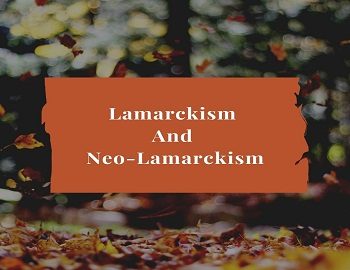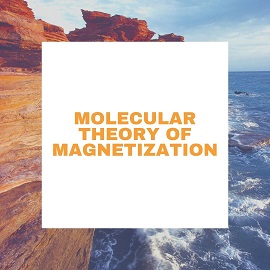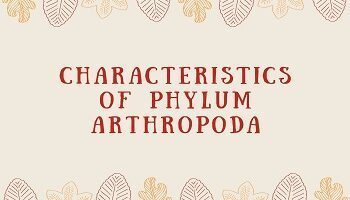Table of Contents
Lamarckism or Theory of Inheritance of Acquired Characters:

The theory of evolution put forward by French biologist Jean Baptiste Lamarck, commonly known as Lamarckism, mainly centers around the inheritance of acquired characters.
Characters are acquired by the use and disuse of different organs and evolution is the result of the adaptation of organisms to the environment.
Lamarck gave his theory in his book ‘Philosophie Zoologique‘ in 1809.
Lamarckism Postulates:
Although Lamarck himself proposed no postulates or law but his theory centers around four ideas, which may name, as postulates.
Postulate I- Theory of Elan Vitae or Growth:
The internal forces of life (Elan Vitae) tend to increase the size of an organism by growth in organs and systems. Thus the internal forces of life are capable of forming organs and systems. For example- a seed, in course of time becomes a tall tree; a zygote after development becomes a giant creature. All the forces of growth remain hidden in the seed and zygote.
Postulate II- Theory of environmental pressure and spontaneous formation of organs:
New organs and systems are formed because of need or want which has arisen due to environmental pressure and continues to be felt by the organism. Changes in the environment initiate need or want in the individual and its ‘internal forces’ direct formation of new organs to meet the changes in the environment.
Postulate III- Theory of use and disuse:
Growth, development, form and functioning of an organ depends upon its use and disuse. Continued use of an organ makes it larger, more elaborate, strong and efficient. Lesser use of an organ makes it small, simpler, weaker and less efficient. Continued disuse will cause gradual decrease in size, degeneration and ultimate elimination of an organ.
Postulate IV- Theory of inheritance of acquired characters:
‘Bodily changes or new characteristics obtained by an organism during its lifetime will automatically get transferred to the next generation’.
While proposing this law, Lamarck did not provide any specific example. He simply believed that due to conditions prevalent in an environment, an organism can use an organ extensively and such usage can lead to a more efficient and perfect nature of that organ. Similarly, an organ not used for a longer period would degenerate. These perfect or degenerate characteristics will be inherited by subsequent generations resulting in new types.
Lamarck cited several examples in support of his theory:
- According to Lamarck, the ancestors of the modern giraffe were small and they had a short neck and forelimbs. They lived in the grasslands of Africa. These ancestral animals were feeding on grasses and the leaves of small trees nearby. Gradually, as the grasslands were transformed into deserts, the animals became dependent on trees for food. Due to competition for the food they had to stretch their neck for more leaves. They strained their neck for several generations with a very strong inner feeling to have a longer neck. This strong desire, in course of time, led to a gradual increase in the length of neck and forelimbs.
- Flightless Birds– The ancestors of flightless birds like kiwi must have been able to fly normally and live on trees. However, in areas devoid of terrestrial predators and abundant food on the ground, the birds must have preferred to remain on the ground most of the time. Wings were used only rarely. Wing’s muscles became weak and ultimately the birds lost the power of flight.
- Cave Dwellers– They are blind animals. Ancestors of cave dwellers must have had normal eyesight. However, under cave conditions, eyesight had no importance. Continued disuse resulted in the degeneration of eyes and the animals became blind. Example- Cave Salamander (Proteus).
- Those birds which started to live in an aquatic environment gradually acquired webbed feet for their survival. This character became hereditary.
- Elongated body and loss of limbs in snakes due to continuous creeping through the holes and crevices.
Critical analysis of Lamarckism:
The Lamarckian theory was exposed to severe criticisms and Lamarck had to defend it throughout his life. It failed to meet scientific tests. Even day-to-day observations indicate its futility. Some objections were as follows.
- The first postulate, the tendency to increase in size, has been noted in many forms, but many times evolution shows reduction in size. Many ferns and conifers, which became extinct were gigantic trees, and the more highly evolved flowering plants are really much smaller in size.
- The second postulate that new organs result from new needs is also not true. In the case of plants, Lamarck believed that the environment acted directly upon the plant, causing the production of new characters that the plant may adapt to its environment. If the development of a new organ or structure depended upon the desire, then why a man who has long desired to fly like birds have not developed the wings?
- The third postulate also could not be understood by many as to how use or disuse of an organ will produce a change in its size and how this change will be brought about in the offspring.
- Scientific experiments have discarded the postulate of the inheritance of acquired characters. Some of the experiments conducted are as follows-
- In 1890, the German Scientist, August Weismann performed some experiments with the rats. He selected a set of healthy male and female rats. He started cutting their tails continually for more than twenty generations. This experiment was performed to verify the inheritance of the acquired character, namely the tailless condition. Interestingly such a condition was never observed in any of the young rats born. This finding led to the proposition of the theory, that any change to the body regions (somatoplasm) will not have influence over the reproductive cells (Germplasm). Thus Weismann, for the first time segregated germplasm from the somatoplasm. This lead to the formulation of the ‘Germplasm theory’ which states that ‘any change to the somatoplasm will not have an influence over the germplasm’.
- In an experiment, a certain variety of fly was bred in complete darkness for about sixty generations. Yet it had no effect upon their vision. This contradicts the loss of eyesight in cave-dwelling animals.
- Boring of ears and nostrils in Indian women has been continued as the tradition from centuries but their offsprings do not show any trace of holes in ears and nostrils.
- Eyes of a voracious reader show neither increase in size nor vision with increasing age. Similarly, the heart doesn’t increase in size though it continues pumping activity throughout life.
Hence, all the above cases and experiments clearly show that the Lamarckian theory is not tenable.
But, in conclusion, we may say that the Lamarckian theory was simple and had some appeal. It was the first completely comprehensive mechanistic theory that was offered. Though this theory could not satisfy his contemporary scientists there can be no denial of the fact that this theory also enjoyed seventy years of popular acceptance.
Neo-Lamarckism:
The term was coined by Packard. Lamarck’s ‘theory of inheritance’ was further studied by a group of scientists. Their ideas supporting Lamarck’s opinion collectively constitute neo-Lamarckism.
The various propositions of Neo-Lamarckism are–
- The driving force for evolution is the environment.
- Change in the environment brings about changes in the heredity of the organisms.
- A number of variations appear in the organisms. At least some of the variations are transferred to the next generation.
- Variations passed on to the progeny are those which influence germ cells or the germ cells are formed from the affected somatic cells.
Neo-Lamarckism produce the following evidence on the transmission of acquired characters among the organisms–
- McDougall (1938) conducted learning experiments on rats. He trained a number of rats to follow certain escape routes from a tank of water and the training was given for about 45 to 50 generations. It was found that there was a decrease in the number of errors made in the learning process generation after generation. Finally, it was found that the off-springs of all the successful rats were able to learn the very behavior of the parents in dealing with the escape routes. This means the inherited behavior is acquired by the offspring.
- Lindsey– He subjected cold-blooded animals, warm-blooded animals, and plants to unusual environmental conditions and found that the environment affects certain changes in these organisms and these acquired modifications were inherited up to some extent in their offsprings.
- Temperature related changes in the body of mice were noted by F.B.Sumner (1910). He reared one set of white mice in warmer temperature (20 – 30°C) and another set in cold conditions. He found that in warmer conditions the mice developed larger ears and longer tails. He further claimed that these characters were inherited.
- Tower exposed young Potato Beetles to extremes of temperature and humidity at the time of development of their sex organs. The drastic changes in the environment did not produce much effect on the young beetles but provided a lot of variations in the offspring. The same was passed on to the next generation.
- Paul Kammerer– He worked on the tailed amphibian ‘Proteus anguinus‘ which lives in complete darkness in the water of the underground cave. It was blind and colourless. He brought Proteus in daylight, due to which it became coloured (brown and black), which passed on to its progeny. Eyes of Proteus also developed normally in daylight. This showed that any change in environmental conditions, induced changes in the animals and the acquired characters were inherited.
To conclude we may say that Neo-Lamarckism has not only provided experimental proof to Lamarckism theory but also provided a logical basis for modifying Lamarckism. The neo-Lamarckians proved that acquired characteristic can be inherited and that adoption is central to the theory of Lamarckism as well as Neo-Lamarckism.








Comments (No)